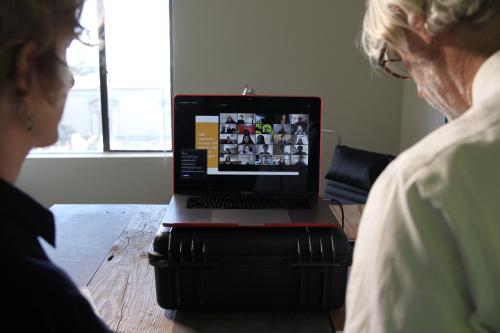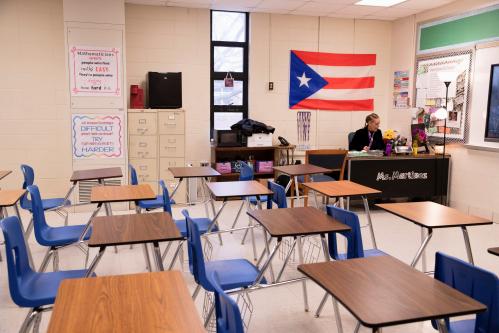Summary
Digital technologies are rapidly developing and transforming the way individuals work, learn, and participate in civic life. As digital innovations become more available and present opportunities to make quality learning and career opportunities more accessible across the globe, educational institutions, administrative data systems, and regulatory frameworks have struggled to adapt. Through research on the landscape of digital micro-credentials, we hope to provide insights and policy recommendations to decisionmakers and stakeholders, such as education and labor policymakers, to expand access to skills and quality jobs to the most disadvantaged learners and workers across the world.
The rapid expansion of new technologies within the education sector in most countries has contributed to the proliferation of alternative models of education, learning, and skill signaling in global labor markets. From digital badges to bootcamps to learning and employment records, a wide range of public, private, and nonprofit initiatives and platforms have emerged to address the ongoing demand for education and new skills among employers and workers alike. Beyond simply moving existing courses and curricula into an online environment, the latest wave of educational innovation represents a more fundamental shift in how education and skills data are gathered, stored, taught, verified, accessed, and signaled in the lab or market. Some experts refer to this shift as “Education 3.0.”
At Brookings, we have recently embarked on a new research agenda focused on understanding where and how these digital innovations in skills and employment pathways are evolving, with a special focus on the extent to which they may expand opportunities for the most vulnerable learners and workers globally. Our goal is to make the education innovation ecosystem more accessible to nontechnical audiences, and specifically to inform decisionmakers worldwide about the promises and perils of these initiatives for expanding access to learning and employment opportunities.
What are the trends in digital innovations in skills and employment pathways, and why should we care?
Although initially the impact of technology in education and labor markets mainly focused on moving existing classes and curricula online and the creation of online job sites like Monster.com, more recent technologies such as machine learning, learning platforms, virtual reality, and distributed ledger technologies, including blockchain, have enabled many more fundamental shifts in how education and labor markets function (Table 1).
Table 1. The evolution of education and skills pathways

In a rapidly changing economy and technological landscape, individuals are using micro-credentials to differentiate themselves in the job market, keep their skills fresh in their industry, and continue working while they advance their education to reduce the financial burden of pursuing a more traditional degree. Micro-credentials are used to signal a certain level of skill attainment, mastery, professional development, or specialization in the labor market that is typically shorter in duration and more specialized than a traditional degree, diploma, or certificate. Micro-credentials can also be designed to be stacked together with others to culminate in a degree. “Digital” credentials signal skills or competencies electronically through data systems, mobile applications, or websites, which are different from a degree or diploma that is verified on paper. Putting the two together, digital micro-credentials represent shorter modules or bundles of learning that are verified and signaled electronically.
A learner interested in developing a skill for a project, job, or future career may seek out digital micro-credentials because they are flexible accelerated forms of learning that demonstrate particular outcomes and skill sets. After completion of a micro-credential, one can communicate their achievement and learning level through a resume, portfolio, or digital platform. The landscape of digital credentials takes various forms and can serve as a bridge to support a career change (Figure 1).
However, just having many new options to advance and signal learning may not necessarily generate upward mobility or support career pivots at scale. Building more permanent and legible onramps and opportunities for transitions will also require institutional adaptation and formal recognition of learning, such as enabling learners to have their previous experience or micro-credentials recognized for transfer across education or labor market institutions (which is rare), addressing information asymmetries about career options, and incentivizing employers—especially small and midsized companies—to offer more professional development to keep skills fresh or advance within an organization.
|
Figure 1. Examples of digital credentials
|
But, despite the rapid development of technology and rising demand for competency-based learning, traditional higher education often excludes many workers and learners because of rigid course structures, expensive programs, a lack of programs designed to meet the needs of working adults or learners with family care responsibilities, and catering to those moving sequentially from secondary to post-secondary education. Across most higher education institutions, course credit requirements or a set number of hours in a structured curriculum must be met to attain a degree. Few of these institutions allow learners to receive credit toward a degree based on previous digital learning, such as micro-degrees, credits from massive open online courses, or other digital credentials.
Why digital credentials and what are the potential risks?
One remedy to the structural barriers in traditional higher education is the “stackable” or modular feature of digital micro-credentials that allows an individual to complement or “stack” upon current or previous education or training. Unbundling longer-term credentials into modular and stackable micro-credentials enables learners more flexibility to make progress on their own schedule while still progressing to a more advanced level of training or a formal degree. The added flexibility that new technologies, such as cloud-based learning platforms or virtual reality, bring can also make learning accessible in places and ways that were not possible before.
Globally, the majority of the labor force does not have a postsecondary degree, and as economies adapt to the future of work, it is critical that the rising demand to gain new skills, remain competitive, and learn through accessible mediums is met. Digital credentialing platforms are inherently flexible because of their potential reach to individuals of all ages, education levels, socioeconomic and racial/ethnic groups, and industry backgrounds. Further, digital credentials and badges may benefit industry sectors in times of skills shortages and economic recessions because learners could receive relevant training and certification in months rather than years.
However, digital micro-credentials may also create new obstacles to learning and equity. For example, governments have to recognize them as steppingstones along a learning path that is at an equivalent level of knowledge or expertise as a degree if they are to hold value or be easily transferred across institutions without the learner having to repeat coursework. In addition, because of the expense associated with formal higher education degree programs in many countries, learners who use micro-credentials in their learning path also may need equivalent access to financial aid and other supports that students frequently rely on to complete their program.
Finally, decisionmakers will need to address the digital divide—access to broadband, connected devices, and digital literacy—to avoid reproducing inequities in access to education and learning. One billion new users have been added to the internet since 2016, and yet 3.7 billion people remain offline with no access to internet or digital literacy skills (UN-Habitat, 2021). The digital divide is the global phenomenon of technological fragmentation, wherein a significant number of communities lack access to information and communication technologies (ICTs). Furthermore, the COVID-19 pandemic has exacerbated inequities and disparities of education systems, with 191 countries and 1.5 billion students affected by school closures (UNESCO, 2020).
As digital micro-credentials scale to meet demand, they may create additional barriers for the most marginalized communities unless governments take parallel steps to prioritize digital inclusion, articulate micro-credentials as legitimate learning pathways, and protect learners from exploitative practices.
Who is leading these micro-credential efforts, where, and why does it matter?
As we began this research project, we found that most of these initiatives are led by governments, education institutions, the private sector, and civil society organizations in the world’s most wealthy, industrialized countries. Yet, youth and adults in low-income countries and in marginalized communities within wealthy countries have the most to gain from the promises of greater access and customization that the latest technologies can bring. They are most likely to be excluded from traditional high-quality education opportunities or have their skills and experience overlooked in the hiring process. Thus, ensuring that the initiatives being developed in more advanced economies are designed to meet the needs of individuals who are largely excluded from existing education and labor market institutions is critical for realizing the promise of digital credentials to improve skills and employment pathways for all.
The lack of engagement of stakeholders and end users in the development of future education technologies is concerning for many reasons. First, technologies such as blockchain for education or learning and employment records are evolving without much input from education leaders in lower-income countries, which ultimately could limit their reach and relevance. Second, there has yet to be a major investment in gathering user input into the design of tools like digital wallets or learning and employment records. This creates the risk of limited buy-in from end users or tools that do not support them in practice, because they were built with untested assumptions. Finally, the lack of engagement of technology experts upfront in the design of regulations and governance frameworks for new technologies and data systems, such as cloud-based administration or privacy laws, is also problematic if the resulting rules or laws are not feasible to implement, have unintended consequences (e.g., for security), or fail to address underlying structural inequities, such as digital infrastructure and literacy. The emerging coalitions, multistakeholder pilots, and user-centered design elements in the U.S. context will be important for shaping whether the value proposition is clear to the intended end users—learners, businesses, or government agencies. Similar collaborations may be necessary to launch in other countries and contexts.
Today, the playing field for learners and workers is determined by where one lives, as well as one’s socioeconomic background, gender, and race and ethnicity. These inequities in access to opportunity are not just an ethical or moral problem for decisionmakers; they also constrain innovation and economic growth by sidelining talented individuals who never got an opportunity to reach their potential and instead get trapped in low-wage, dead-end jobs.
In a future report, we will take stock of this landscape and provide an accessible framework to make sense of the evolving global ecosystem of digital credentials. Through our research, we hope to provide insights and policy recommendations to decisionmakers and stakeholders to expand access to skills and quality jobs to the most disadvantaged across the world.








